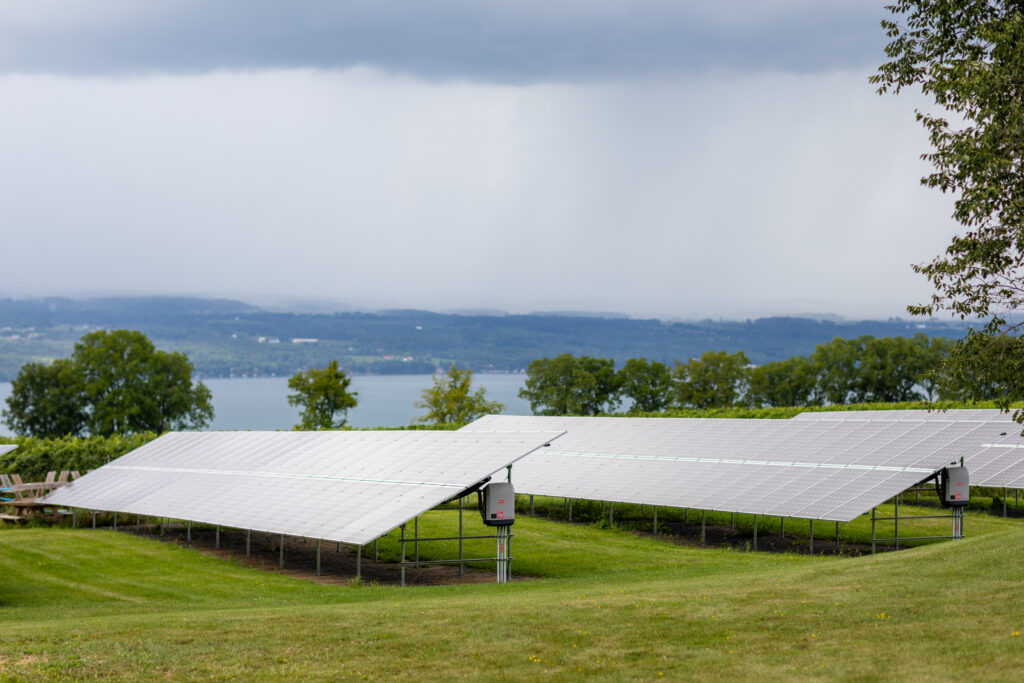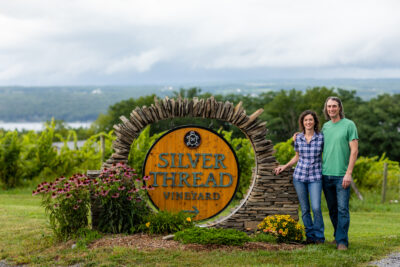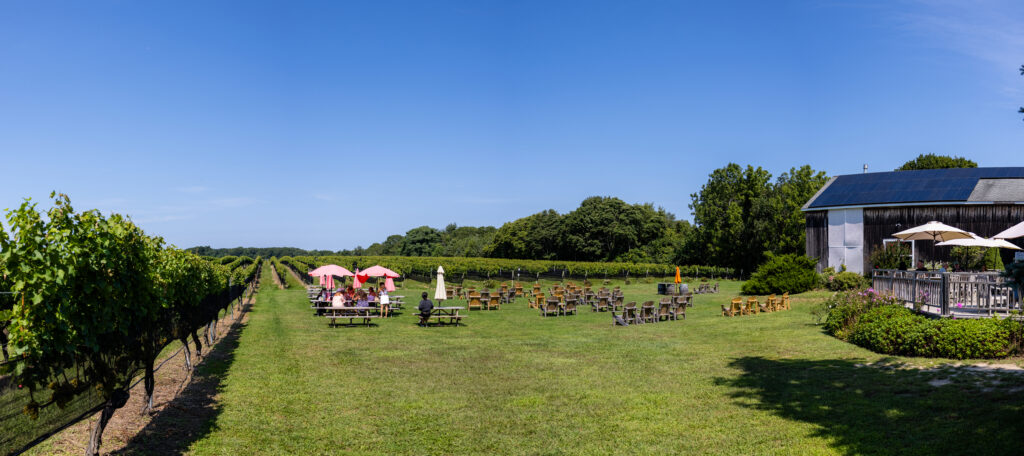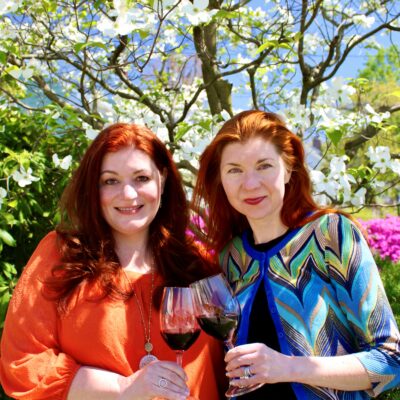The ritual of popping a cork on a bottle of wine after a long day at work or before a weekend meal comes with many things. Your favorite corkscrew. Your favorite glassware. The feeling of stress leaving your body when you hear the cork pop, you pour the wine, and then inhale the captivating aromas. The indescribable satisfaction of the first sip. What that ritual probably doesn’t come with is the question in your mind: I wonder if this wine was made using solar energy?
Wine is often described as bottled poetry, a product of the sun, soil, and water, we don’t often think about the sun also powering the cellar that ferments and ages that poetry.
Thankfully, New York State vintners spend a great deal of time thinking about how they can leverage the power of the sun in the vineyard and cellar.
Today, more and more New York wineries are fueling their operations with the sun’s rays and reaping the benefits of lower energy bills. While sustainability is their primary inspiration, their solar-fueled operations come with the added bonus of being pretty good PR, too.
The New York wineries that have been using solar energy for years are sold on the alternative energy option, and they have experience and advice to pass on to those considering adding solar panels to the roofs of their buildings and to open space on their land.
The Benefits of Powering a Winery With Solar
“Most months utility bills are zero,” says Josh Wig, co-owner of Lamoreaux Landing Wine Cellars along Seneca Lake. It took a while to get there, though. The winery first put solar panels on a rooftop about 15 years ago. The benefits were significant, enough that Lamoreaux eventually added a second array in a field in 2016. Now the buy-in to solar energy meets 100% of the energy needs of the buildings and winemaking operations at Lamoreaux.
The demand for electrical power isn’t huge year-round, but during harvest when Wig needs to process the fruit, there’s a sharp increase in demand. Now the solar offsets even the energy demands during harvest.
Lamareaux has plans for a third array in the works so that it can become a net-generating station, producing more energy than it uses.

At Silver Thread Winery on Seneca Lake, current owners Shannon and Paul Brock bought the property already set up for solar. The winery’s original owner built the building with solar panels in mind back in the 1990s, but at that time, it was too cost prohibitive to install them.
When the Brocks added solar, many of the barriers to solar installation were gone.

“In 2015, there were lots of programs available to promote solar installations on farms. We were able to take advantage of first an energy audit where a professional came out and evaluated our situation for energy use and needs.”
The auditor helped Silver Thread put an energy plan in place that included solar, but also involved insulation and energy efficient heating and cooling in the form of air source heat pumps.
“It was essential that we do that in conjunction with the solar to make the solar more effective,” says Shannon Brock.
The solar arrays at Silver Thread generate 125% of the winery’s needs, and the winery’s energy bills are very, very low.
Of course, the winery is still paying off the low-interest loan for the solar.
“During the 10 years you’re paying for your system, you’re breaking even,” says Brock. When that ten years is over, though, there will be many years of no- or very-low electricity bills.
You Don’t Have to Go 100% In
Not all wineries that have solar use it for their entire operations. When they don’t, they choose which operations would benefit most from being powered by solar.
On Long Island’s North Fork, Sparkling Pointe produces all methode champonoise style sparkling wines that age in a warehouse anywhere from one to eight years. Storage requires a large amount of climate-controlled warehouse space. It made sense for Sparkling Pointe to put solar on the warehouse that holds all those aging bottles when it was built. The building also uses geothermal energy.
“We knew it would be very, very, very efficient because the wine has a lot of thermal mass and holds the temp really well. Between the geothermal and the solar, it’s essentially a zero energy building. We are able to generate all of the electric that we need for that warehouse,” says Michael Falcetta, Sparkling Pointe’s general manager.
“Separated warehouses are really economical for solar when storing wine or something liquid. When we get the building to a temperature, the wine in all of these bottles are at the temperature as well and they do a good job holding the temperature,” he says.
He advises anyone considering solar to get a thorough analysis of the needs of their operations because they may find that doing solar for part, not all, of their operations is a good way to start.
Ready for Electric Vehicles
Paumanok Vineyards on the North Fork of Long Island has been 100% solar since 2017.

Still, they implement other measures to save electricity including changing light bulbs and changing where they store their barrels.
“We used to use a lot more electricity for refrigeration to cold stabilize our wines,” says Paumanok’s winemaker Kareem Massaud. “It’s one of the biggest electrical consumption operations in the winery.”
So Paumanok has moved barrels outdoors for the winter or used new products that eliminate the need for chilling the barrels.
The winery does anticipate a bump in electrical use in the future, but it’s ultimately for a sustainable reason—it’s waiting on a delivery of electric tractors for the vineyards.
“We ordered three electric tractors,” says Massaud. Supply chain issues have slowed the delivery of the tractors, but with the sun generating more electricity at Paumanok than they actually use, they’ll be ready when they arrive.
“If we are 100% solar powered, what gets really exciting from a sustainability standpoint is eliminating the consumption of diesel as we transition to electric tractors with electricity coming from our own solar panels,” he says.
Paumanok also has an EV (electric vehicle) charger at the winery for customers to use that’s already being powered by the energy its solar panels produce.
Making wine is ultimately an act of agriculture, dependent on the whims of Mother Nature. “Using” the sun’s rays to also help power the operation in the cellar is an innovative way to help pay mom back for all of her hard work. In the process, the New York wine industry is proving, once again, that sustainability is a priority now and in the future.

